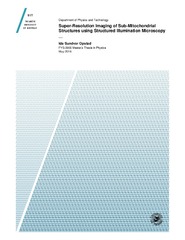Super-Resolution Imaging of Sub-Mitochondrial Structures using Structured Illumination Microscopy
Permanent link
https://hdl.handle.net/10037/11063View/
Movie 1 (Unknown)
Movie 2 (Unknown)
Movie 3 (Unknown)
Movie 4 (Unknown)
Movie 5 (Unknown)
Movie 6 (Unknown)
Movie 7 (Unknown)
Movie 8 (Unknown)
Movie 9 (Unknown)
(PDF)
Date
2016-05-15Type
Master thesisMastergradsoppgave
Author
Opstad, Ida SundvorAbstract
Modern science is based on observation, and its advances are limited by what is
possible to observe. For centuries optical microscopy was limited by the diffraction
of light, making structures closer together than half the wavelength of light
unresolvable. In recent years, the new field of optical nanoscopy has emerged,
enabling diffraction-limited structures to be resolved. As opposed to electron
microscopy, optical microscopy enables observing biological samples live. The
new observational tools give hope for a revolution within biological sciences,
because a much closer look at inter- and intracellular processes has become
possible. Observing is, however, not without affecting the system under observation.
This becomes especially evident while observing living nano-structures.
Here, I optimize parameters for live cell imaging by structured illumination
microscopy (SIM) and compare the results with diffraction-limited microscopy.
Specifically, I target different mitochondrial structures by combining both dual
transfection with MitoTracker labeling, which results in the ability to resolve
three different mitochondrial structures at once in living cells.
Time-lapse imaging was done with SIM and also compared with diffractionlimited
deconvolution microscopy (DV). SIM required higher signal-to-noise ratios
for successful imaging and was light intensive compared to DV. SIM caused
quick photobleaching of the sample (limiting the number of frames possible)
and clear phototoxic effects, resulting in morphological artifacts. In comparison,
time-lapse with DV enabled more time points, larger field of view and eliminated
any apparent morphological artifacts. Mitochondrial and (diffraction-limited)
fenestration dynamics in the membrane of liver sinusoidal endothelial cells was
also captured using SIM, and, finally, SIM artifacts and challenges are discussed.
While optical nanoscopy could still be a preferred option for imaging a few
time-points of diffraction-limited structures, the extra photon cost still makes
DV a better tool for studies not strictly requiring the higher resolution (like
monitoring mitochondrial dynamics). This points future development of live
cell nanoscopy in the direction of lower illumination intensities coupled with
(non-toxic) brighter and photostable fluorophores. The preferred imaging tool
would be an optical platform allowing for specific application-tailored resolution,
minimizing the phototoxicity and photobleaching with a flexible field of view.
Publisher
UiT Norges arktiske universitetUiT The Arctic University of Norway
Metadata
Show full item recordCollections
- Mastergradsoppgaver IFT [102]
Copyright 2016 The Author(s)
The following license file are associated with this item:


 English
English norsk
norsk
